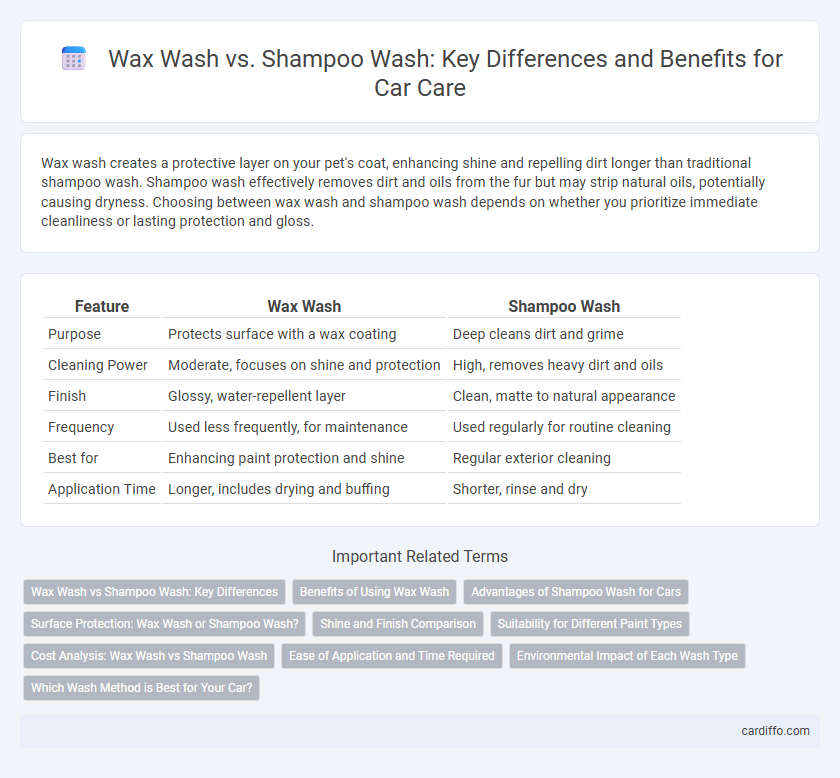Wax wash creates a protective layer on your pet's coat, enhancing shine and repelling dirt longer than traditional shampoo wash. Shampoo wash effectively removes dirt and oils from the fur but may strip natural oils, potentially causing dryness. Choosing between wax wash and shampoo wash depends on whether you prioritize immediate cleanliness or lasting protection and gloss.
Table of Comparison
| Feature | Wax Wash | Shampoo Wash |
|---|---|---|
| Purpose | Protects surface with a wax coating | Deep cleans dirt and grime |
| Cleaning Power | Moderate, focuses on shine and protection | High, removes heavy dirt and oils |
| Finish | Glossy, water-repellent layer | Clean, matte to natural appearance |
| Frequency | Used less frequently, for maintenance | Used regularly for routine cleaning |
| Best for | Enhancing paint protection and shine | Regular exterior cleaning |
| Application Time | Longer, includes drying and buffing | Shorter, rinse and dry |
Wax Wash vs Shampoo Wash: Key Differences
Wax wash effectively removes stubborn residues from hair styling products, providing a deep clean that shampoo wash may not fully achieve. Shampoo wash primarily targets dirt, oil, and sweat, maintaining scalp health and hair softness without stripping essential moisture. Understanding the key differences ensures choosing the right wash method based on hair type and styling product use for optimal hair care results.
Benefits of Using Wax Wash
Wax wash offers superior cleansing by effectively removing dirt and oils without stripping natural moisture, unlike traditional shampoo washes. It provides a protective layer that enhances hair shine and reduces frizz, promoting healthier, more manageable hair. Regular use of wax wash can extend the longevity of hairstyles and improve overall scalp health by maintaining its natural balance.
Advantages of Shampoo Wash for Cars
Shampoo wash for cars effectively removes dirt, grease, and road grime without stripping the protective wax layer, preserving the vehicle's shine and finish. It provides a deep clean with specialized formulations that break down contaminants gently, reducing the risk of paint damage compared to harsh wax washes. Shampoo washes also improve water sheeting during rinsing, minimizing water spots and promoting a streak-free, polished appearance.
Surface Protection: Wax Wash or Shampoo Wash?
Wax wash provides a protective layer that shields the vehicle's surface from contaminants and UV rays, enhancing paint longevity and maintaining a glossy finish. Shampoo wash primarily focuses on cleaning by removing dirt and grime but lacks the protective properties that wax offers. For sustained surface protection, wax wash is the superior choice compared to shampoo wash.
Shine and Finish Comparison
Wax wash enhances hair shine by creating a glossy, protective layer that reflects light, resulting in a polished finish without stripping natural oils. Shampoo wash cleanses the scalp and hair more deeply, removing dirt and buildup but may leave hair with a duller appearance if overused. For a vibrant shine and smooth finish, wax wash is preferred, while shampoo wash is essential for maintaining scalp health and cleanliness.
Suitability for Different Paint Types
Wax wash is ideal for protecting and enhancing the shine of softer paint finishes such as clear coats and single-stage paints by providing a protective hydrophobic layer. Shampoo wash works best for all paint types, including OEM and ceramic coatings, as it effectively removes dirt and contaminants without stripping wax or sealants. Choosing between wax wash and shampoo wash depends on the paint's condition and the desired level of protection or cleaning intensity.
Cost Analysis: Wax Wash vs Shampoo Wash
Wax wash typically incurs higher upfront costs due to specialized products and application tools, whereas shampoo wash involves lower initial expenses with readily available and affordable products. Over time, wax wash may reduce frequency of applications by providing longer-lasting protection, potentially offsetting its higher price per use. Shampoo wash requires more frequent applications, resulting in cumulative costs that can surpass the expense of wax wash depending on usage patterns.
Ease of Application and Time Required
Wax wash offers a more straightforward application process, requiring less time as it can be directly spread onto surfaces without extensive lathering. Shampoo wash demands additional effort for thorough mixing and cleansing, often extending the total wash time due to the need for repeated rinsing. The ease of application and quicker results make wax wash a preferred choice for fast, efficient cleaning tasks.
Environmental Impact of Each Wash Type
Wax wash generates less wastewater and uses fewer synthetic chemicals compared to shampoo wash, resulting in a lower environmental footprint. Shampoo wash often contains sulfates and parabens that can contaminate waterways and harm aquatic ecosystems. Choosing wax wash can enhance sustainability by minimizing toxic runoff and reducing resource consumption in cleaning processes.
Which Wash Method is Best for Your Car?
Wax wash involves applying a protective wax coating during the washing process, enhancing your car's shine while providing a layer of protection against dirt and environmental damage. Shampoo wash uses a specialized car shampoo to effectively remove grime and contaminants without the added protective benefits of wax. Choosing the best wash method depends on your car's current protection level and desired finish; for long-lasting protection and a glossy look, wax wash is ideal, while shampoo wash is suitable for regular cleaning without buildup.
Wax Wash vs Shampoo Wash Infographic

 cardiffo.com
cardiffo.com